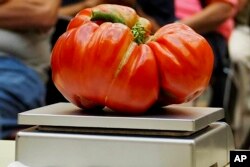Tomatoes are the most popular crop among American home gardeners.
Garden writer Jessica Damiano says there are many good reasons to grow your own tomatoes. Just the smell of homegrown tomatoes, Damiano says, will remind you of summer.
A major benefit of growing your own tomatoes is variety. If you visit a garden center, you will find seeds and small starter plants for yellow tomatoes, purple tomatoes, huge tomatoes, and even very small tomatoes. There are kinds you simply cannot find at a local food store.
Damiano loves tomatoes. In fact, she created and hosted The Great Long Island Tomato Challenge while working for a local newspaper in the state of New York. The gatherings of people who love tomatoes, or “tomatophiles,” continued for 13 years. One tomato that was entered into the challenge weighed more than 2.3 kilos.
Damiano also got to meet and speak with the competitive tomato growers who raised the winning fruits. It did not take long for her to notice some common practices among them.
Tomatoes are not difficult to grow. The most important things are to give the plants plenty of water, well-draining soil, heat and light. It is best to grow tomatoes in a place that receives at least six hours of sunlight each day. Removing weeds will keep pests and diseases away while giving the plants enough nutrients to produce fruit.
Tomatoes grow best in soil with a pH level between 6.0 and 6.8. If the pH reading is lower than 6.0, you can add about 2 cups of dolomitic lime into the soil for each plant. Make sure to mix it deep into the soil -- down to around 30 centimeters.
If you want to grow really big tomatoes, try following these seven tips from expert growers:
- Select tomato seeds with names like Big Zac, Porterhouse, Rhode Island Giant or Bull’s Heart. They are all genetically designed to produce large fruit
- Start seeds early indoors and re-plant them into larger containers several times before moving them outdoors. Plant them deeply each time, removing leaves from the bottom one-third of plants and burying stems up to the next set of leaves. This will produce stronger plants.
- Remove new flowers that develop at the top of the plant when older fruits near the bottom begin to grow. This will force the plant to produce fewer but larger tomatoes.
- Pay close attention! Observe the plants daily for pests and diseases. React quickly to prevent problems.
- Remove the small growths where the plant’s stems and branches meet. This will prevent them from taking away nutrients and shading developing fruit under them.
- Cut back, or prune, the plants to keep only one main branch instead of letting them develop into a shorter, wider shrub.
- Finally, water, fertilize and weed!
I'm Jill Robbins. And I’m Faith Pirlo.
Jessica Damiano reported this for the Associated Press. Hai Do adapted the story for Learning English.
_______________________________________________________________________
Words in This Story
benefit - n. good result or effect
variety - n. a number of different things
challenge - n. an invitation to compete in an event










